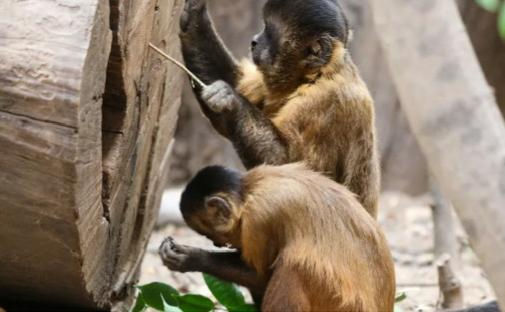Capuchin monkeys: the first Brazilian non-human primates with a proven culture
- GEAS Brasil
- Nov 21, 2024
- 2 min read
The term "culture" can be defined as a body of knowledge that is learned and passed on between generations, in addition to the knowledge that is innate to individuals, which we call "instinct" (TYLOR, 1871). For many years, we believed that only human primates wewe capable of having a culture of their own, and that animals were guided only by instinctive impulses (WAAL, 2001).
Researchers from the Neotropical Primates Research Group (Neoprego) have made an important discovery in the Ubajara National Park in Ceará. This is a group of yellow-breasted capuchin monkeys (Sapajus libidinosus) which, faced with a scenario of scarcity in the droughts of the caatinga, use tools - such as stones and sticks - to dig up the ground in search of spiders, an important resource in the diet of these individuals (FALÓTICO, 201;FALÓTICO, 2024); as well as using stones as a tool for cracking chestnuts. In addition, Rufo and colleagues (2024) also show that another group of S. libidinosus, in the Serra da Capivara National Park, has developed a processing strategy to avoid ingesting parts of the gastroenteric tract of wood locusts, which would have an unpleasant taste and potential toxicity.


Serra da Capivara, Piauí, Brazil. Credits: Tiago Falótico, School of Arts, Sciences and Humanities - University of São Paulo (EACH-USP).

What these behaviors have in common, besides being a fascinating demonstration of the cognitive potential of these primates, is that they are skills and knowledge that are learned by the young from their elders - characterizing a cultural activity, in other words, there is clear learning between generations; since customs and knowledge are passed on from one or more individuals to their descendants. This knowledge varies in occurrence between ages and sexes, demonstrating that aspects of the social organization of these groups are also
linked to the occurrence of certain behaviours - as happens in human societies (FALÓTICO, 2024).
In this sense, the capuchin monkeys described here have another interesting peculiarity: they have their own archaeological sites, which show at least 3,000 years of the practice of using rocks to crack nuts. These tools vary in size according to their age, indicating that their use was adapted to consume foods with different degrees of hardness (FALOTIC, 2019).
Drawing a parallel with archaeological and anthropological studies of the human species, researcher Tomos Proffit claims that these primates were experiencing their own "Stone Age", demonstrating the fascinating spectacle of evolution taking place in the Brazilian caatinga. Whether this historic milestone will evolve into a cognitive-technological development similar to that of humans is impossible to predict - for now, we can only study this incredible phenomenon and closely follow the next steps of these impressive primates.


Comments